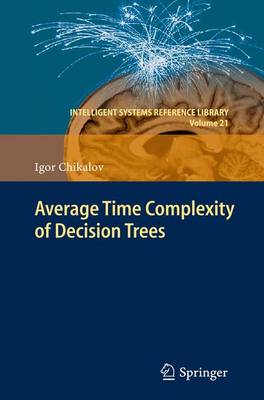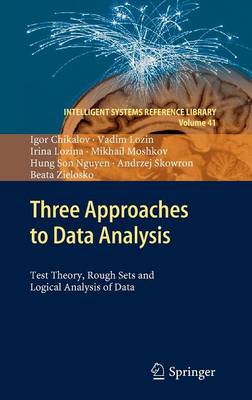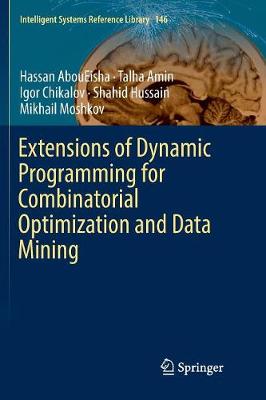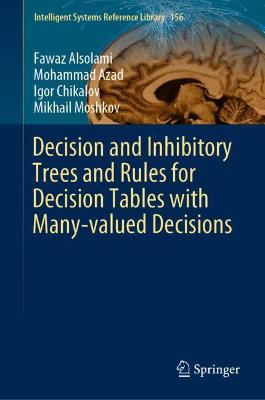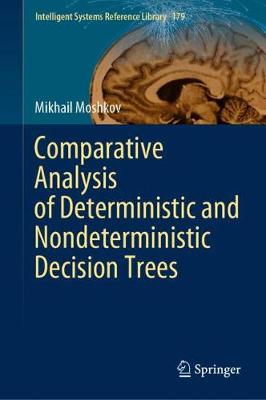Intelligent Systems Reference Library
5 primary works
Book 21
Decision tree is a widely used form of representing algorithms and knowledge. Compact data models
and fast algorithms require optimization of tree complexity. This book is a research monograph on
average time complexity of decision trees. It generalizes several known results and considers a number of new problems.
The book contains exact and approximate algorithms for decision tree optimization, and bounds on minimum average time
complexity of decision trees. Methods of combinatorics, probability theory and complexity theory are used in the proofs as
well as concepts from various branches of discrete mathematics and computer science. The considered applications include
the study of average depth of decision trees for Boolean functions from closed classes, the comparison of results of the performance
of greedy heuristics for average depth minimization with optimal decision trees constructed by dynamic programming algorithm,
and optimization of decision trees for the corner point recognition problem from computer vision.
The book can be interesting for researchers working on time complexity of algorithms and specialists
in test theory, rough set theory, logical analysis of data and machine learning.Book 41
Three Approaches to Data Analysis
by Igor Chikalov, Vadim Lozin, Irina Lozina, Mikhail Moshkov, Hung Son Nguyen, Andrzej Skowron, and Beata Zielosko
In this book, the following three approaches to data analysis are presented:
- Test Theory, founded by Sergei V. Yablonskii (1924-1998); the first publications appeared in 1955 and 1958,
- Rough Sets, founded by Zdzisław I. Pawlak (1926-2006); the first publications appeared in 1981 and 1982,
- Logical Analysis of Data, founded by Peter L. Hammer (1936-2006); the first publications appeared in 1986 and 1988.
These three approaches have much in common, but researchers active in one of these areas often have a limited knowledge about the results and methods developed in the other two. On the other hand, each of the approaches shows some originality and we believe that the exchange of knowledge can stimulate further development of each of them. This can lead to new theoretical results and real-life applications and, in particular, new results based on combination of these three data analysis approaches can be expected.
- Logical Analysis of Data, founded by Peter L. Hammer (1936-2006); the firstpublications appeared in 1986 and 1988.
These three approaches have much in common, but researchers active in one of these areas often have a limited knowledge about the results and methods developed in the other two. On the other hand, each of the approaches shows some originality and we believe that the exchange of knowledge can stimulate further development of each of them. This can lead to new theoretical results and real-life applications and, in particular, new results based on combination of these three data analysis approaches can be expected.
These three approaches have much in common, but researchers active in one of these areas often have a limited knowledge about the results and methods developed in the other two. On the other hand, each of the approaches shows some originality and we believe that the exchange of knowledge can stimulate further development of each of them. This can lead to new theoretical results and real-life applications and, in particular, new results based on combination of these three data analysis approaches can be expected.
Book 146
Extensions of Dynamic Programming for Combinatorial Optimization and Data Mining
by Hassan AbouEisha, Talha Amin, Igor Chikalov, Shahid Hussain, and Mikhail Moshkov
Dynamic programming is an efficient technique for solving optimization problems. It is based on breaking the initial problem down into simpler ones and solving these sub-problems, beginning with the simplest ones. A conventional dynamic programming algorithm returns an optimal object from a given set of objects. This book develops extensions of dynamic programming, enabling us to (i) describe the set of objects under consideration; (ii) perform a multi-stage optimization of objects relative to different criteria; (iii) count the number of optimal objects; (iv) find the set of Pareto optimal points for bi-criteria optimization problems; and (v) to study relationships between two criteria. It considers various applications, including optimization of decision trees and decision rule systems as algorithms for problem solving, as ways for knowledge representation, and as classifiers; optimization of element partition trees for rectangular meshes, which are used in finite element methods for solving PDEs; and multi-stage optimization for such classic combinatorial optimization problems as matrix chain multiplication, binary search trees, global sequence alignment, and shortest paths. The results presented are useful for researchers in combinatorial optimization, data mining, knowledge discovery, machine learning, and finite element methods, especially those working in rough set theory, test theory, logical analysis of data, and PDE solvers. This book can be used as the basis for graduate courses.
Book 156
Decision and Inhibitory Trees and Rules for Decision Tables with Many-valued Decisions
by Fawaz Alsolami, Mohammad Azad, Igor Chikalov, and Mikhail Moshkov
The results presented here (including the assessment of a new tool - inhibitory trees) offer valuable tools for researchers in the areas of data mining, knowledge discovery, and machine learning, especially those whose work involves decision tables with many-valued decisions. The authors consider various examples of problems and corresponding decision tables with many-valued decisions, discuss the difference between decision and inhibitory trees and rules, and develop tools for their analysis and design. Applications include the study of totally optimal (optimal in relation to a number of criteria simultaneously) decision and inhibitory trees and rules; the comparison of greedy heuristics for tree and rule construction as single-criterion and bi-criteria optimization algorithms; and the development of a restricted multi-pruning approach used in classification and knowledge representation.
Book 179
Comparative Analysis of Deterministic and Nondeterministic Decision Trees
by Mikhail Moshkov
This book compares four parameters of problems in arbitrary information systems: complexity of problem representation and complexity of deterministic, nondeterministic, and strongly nondeterministic decision trees for problem solving. Deterministic decision trees are widely used as classifiers, as a means of knowledge representation, and as algorithms. Nondeterministic (strongly nondeterministic) decision trees can be interpreted as systems of true decision rules that cover all objects (objects from one decision class).
This book develops tools for the study of decision trees, including bounds on complexity and algorithms for construction of decision trees for decision tables with many-valued decisions. It considers two approaches to the investigation of decision trees for problems in information systems: local, when decision trees can use only attributes from the problem representation; and global, when decision trees can use arbitrary attributes from the information system. For both approaches, it describes all possible types of relationships among the four parameters considered and discusses the algorithmic problems related to decision tree optimization. The results presented are useful for researchers who apply decision trees and rules to algorithm design and to data analysis, especially those working in rough set theory, test theory and logical analysis of data. This book can also be used as the basis for graduate courses.
